The following article and sketches appeared in the "Illustrated Sydney News" on Friday 16 November 1866:
DARLINGHURST GAOL.
THIS prison is situated on the site of Woolloomooloo Stockade, and was erected for Imperial convicts, who quarried and cut the stone and partly built the outer walls. Two wings and principal gaoler's quarters were built by free labour during 1840, when, in consequence of the great destitution among the working classes, the Government found it necessary to employ a number of mechanics upon work which was not then absolutely required.
On 7th June, 1841, the prisoners were transferred from the old gaol in George-street, to Darlinghurst, the prison then consisting of the north and south wings only — the present walls enclosing the stockade as well as the prison — admission to the stockade being obtained through a gateway on the eastern wall; this gateway has been for some years closed up; though until up to 1865/66 the eastern part of the enclosure has been known in the prison as 'The Stockade.'
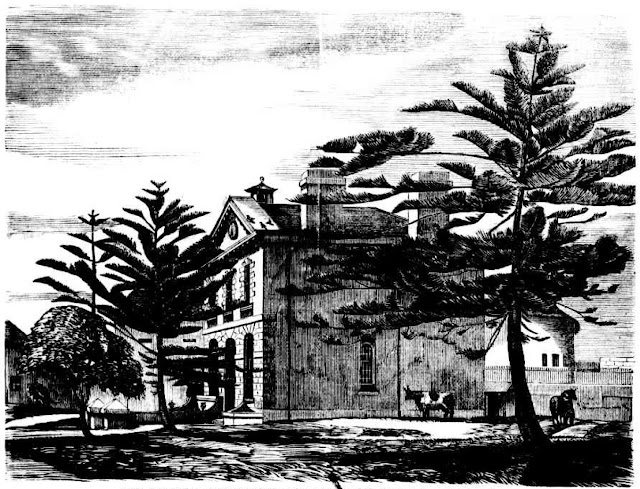 |
| The Residence of the Governor of the Goal (Within the Walls) |
The prison now consists of four wings on the radiating principle, the fourth having been erected wholly by, prison labour. Debtors' prison, with principal warders' quarters, hospital, bath house, workshops, the stone for these buildings, as well as for the division walls to yards, has been cut by prisoners. The buildings have been put up mostly by free labour.
The north or trial A wing, on ground floor, 24 single cells, each 8 x 5 x 10 ft. high; middle and top landings, 24 large cells, each 12 x 2 x 10 ft. high. North-east, labour or B wing, 42 cells, 12 x 8 x 10 ft. high. South-east, new or C wing, 78 single cells, each 8 x 5 x 10 ft. high. South, females or D wing, 36 large cells, 12 x 8 x 10 ft. high, and 6 cells, 8 x 5 x 10 ft. high. In all 102 large cells, calculated to accommodate 3 prisoners each, and 108 single; that is, accommodation for 414 prisoners.
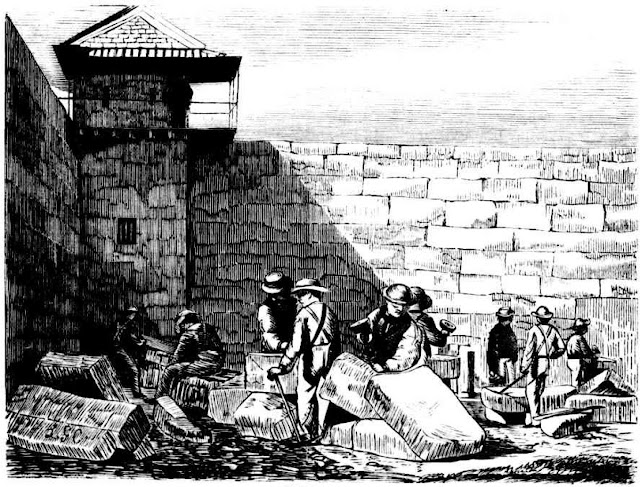 |
| Stone Cutters |
Two of the large cells are padded for lunatics, others are used as stores; so that the actual room in the gaol is for 400 prisoners, without allowing for casualties or unequal division of classes.
The hospital, 1 ward, 25 x 24 x 12 ft. high ; 1 ward, 25 x 22 x 12 ft. high, room of 8 beds in each, for males. For females—1 ward, 25 x 22 x 12 ft. high, 10 beds. Debtors' prison, ground floor, 4 sleeping cells, each 12 x 8 x 11 ft high; upstairs 2 sleeping cells 12 x 8 13 feet high; and common room 22 x 18 x 13 ft. high.
The old yard contains 3¼ acres, and the new one, 1¼ acre; the whole surrounded by a strong wall 20 feet high.
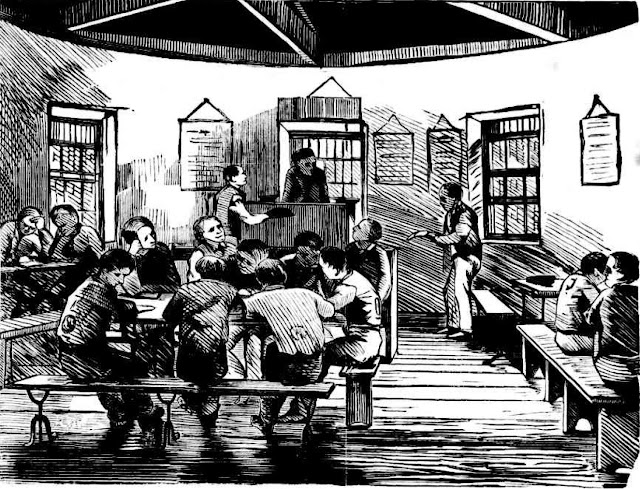 |
| The School Room |
Number of prisoners: —
Daily average the last five years :—
1861 . . . 310
1862 . . . 320
1863 . . . 375
1864 . . . 437
1865 . . . 475
Greatest number at any one time :—
1861 . . . 419
1862 . . . 436
1863 . . . 480
1864 . . . 495
1865 . . . 548
Total number received during 1865: For trial, males 190, females 47, total 237; examination, males 168, females 44, total 212; in transit, males 62, females 27, total 89. Under sentence: Labour, males 590, females 93, total 683 ; imprisonment only, males 1117, females 1123, total 2240; debtors, males 38, females 3, total 41. Of this number there have come into gaol: More than once, males 236, females 98, total 334; more than twice, males 87, females 38, total 125; more than thrice, males 163, females 295, total 458. Many, particularly women have been admitted as often as 15 or 16 times during the year, some more frequently.
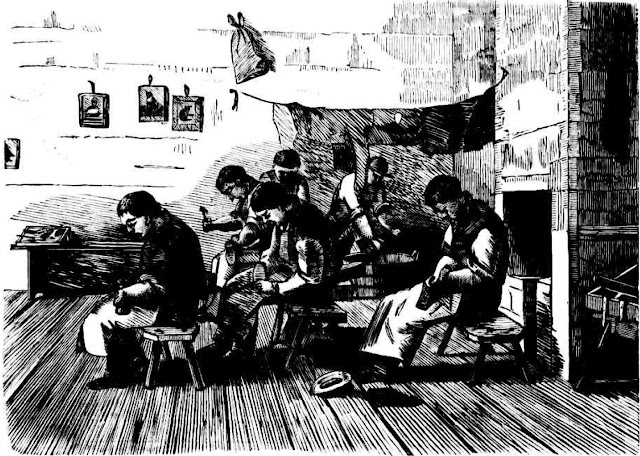 |
| The Shoe-Making Room |
Employment consists of stone cutting for building purposes, mat making and weaving, tailoring, shoemaking, bookbinding ; carpenters, painters, smiths, and coopers, are employed at their trades. Expert mechanics are very few, and difficulty is met with in providing employment for so many men having no knowledge of the use of tools.
In August, 1865, an overseer of trades was appointed to superintend the work of tailors, shoemakers, and bookbinders. A number of men have been successfully employed making shoes and clothing for prison use. Previous to August but 2 tailors and 2 shoemakers were at work mending prisoners' clothing. From August to end of the year the numbers employed averaged-tailors, 13; shoemakers, 11; bookbinders, 3; matmakers, 17; these men earned £750. Deducting from that the cost of material and salaries of overseers that left a clear profit of £300 in the four months; since then their labour has been of equal if not of more value. One thousand pairs of shoes have been made from August to present time, at a cost for material of about 2s. 3d. per pair ; these shoes cost by contract 5s. 3d. per pair. The making of clothing is not so profitable, in consequence of the high prices to be paid for material. Grey cloth for winter wear cannot be had in Sydney.
Return of value of labour during 1865 estimated at £6700, principally earned by stonecutters, who cut 33,026 feet of stone; by matmakers, who made 1023 door mats ; weavers, who made 4000 yards matting.
It must be borne in mind that nearly all the men at work have to be taught.
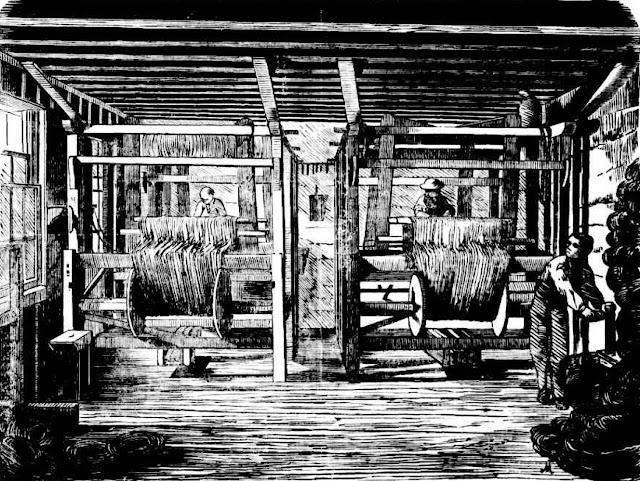 |
| The Matting Manufactory |
Hours of labour from 7 to 8, 9 to 12, and 1 to 4; in all, 7 hours. A great many attend school; some one hour, others two hours, thereby reducing the hours of labour one and two hours daily.
Too much credit cannot be given o Mr. Read, the present Governor of the Gaol for his philanthropic efforts to better the condition of the prisoners by teaching them trades that will afford an honest livelihood when their sentences have expired, and also for his attempt to solve the problem of how to make prisoners support themselves.
The workshops are situated in the building which runs across the top of illustration No. 1, on the upper floor of which, on the occasion of our visit we found Gardiner (the bushranger) and other notorious criminals busy making mats, and in an adjoining room, weaving matting, was an unfortunate young man who owes his loss of liberty to the temptations of Gardiner and Gilbert. No time seems to be wasted, no conversation permitted, or anything that would divert attention. The store contained piles of matting, mats, and other manufactures, some of which have since found their way to the Intercolonial Exhibition.
Source: Sketches of Darlinghurst Gaol (1866, November 16). Illustrated Sydney News (NSW : 1853 - 1872), p. 13.
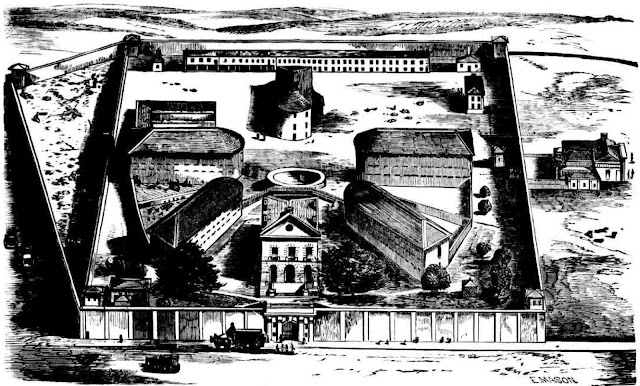







No comments